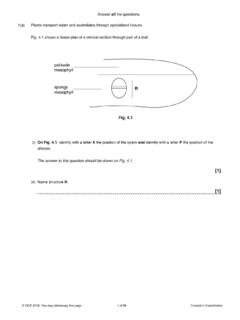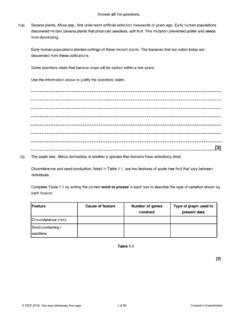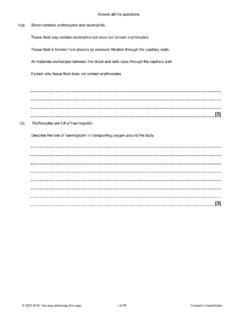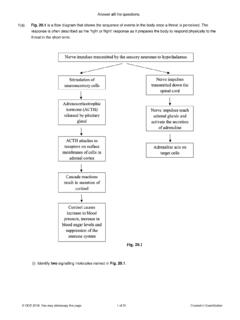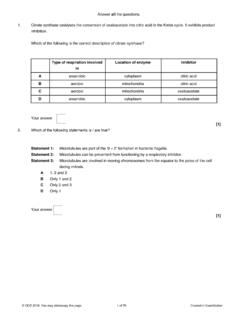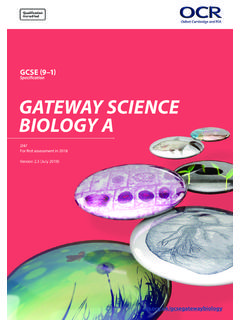Transcription of 6.1 Cellular Control OCR ExamBuilder - Calder Learning Trust
1 Answer all the questions. 1. What is an operon? A The binding site for a repressor protein. B Any group of genes responsible for the metabolism of lactose in prokaryotes or eukaryotes. C A cluster of genes under the Control of a promoter. D A regulatory gene. Your answer [1]. 2. There will be outbreaks of new infectious diseases in the future. They will arise from mutations in the genomes of existing organisms. The mutating organisms may not at present be pathogenic, or they may be animal pathogens that mutate to become able to infect humans. What feature of a pathogen such as Mycobacterium tuberculosis could be altered by a mutation, making a vaccine ineffective?
2 [1]. 3. A gene codes for the production of lactase. This gene is normally switched off after an infant moves to adult food. Almost all adult mammals are unable to digest lactose. They are said to be lactose intolerant. Humans are an exception. Most humans have a genetic mutation that prevents the shutdown of lactase production. State what structural detail of a polypeptide is altered by gene mutations. [1]. OCR 2018. You may photocopy this page. 1 of 31 Created in ExamBuilder 4. The table shows the genetic code in a short length of DNA, the corresponding codons on mRNA, and the anticodons on the corresponding tRNA.
3 Row Original DNA mRNA tRNA. A CCG TTA GCA GGC AAT CGU CCG TTA GCA. B CAT AAT ACG GUA UUA UGC CAU AAU ACG. C ATA CGC ATC AUA CGC UAG UAU GCG AUC. D ACG GTA AAA ACG GAU UUU ACG GTA AAA. Which of the rows, A to D shows the correct codons and anticodons? Your answer [1]. OCR 2018. You may photocopy this page. 2 of 31 Created in ExamBuilder 5. The bacterium E. coli produces lactase only when the sugar lactose is available. The mechanism to Control production of lactase is called the lac operon. Statements 1 3 describe the role of molecules in the way the lac operon controls lactase production.
4 1 lactose binds to the repressor protein 2 the repressor protein binds to lactase 3 lactase leaves the cell Which of the options, A to D, identifies the correct statements? A 1, 2 & 3. B Only 1 & 2. C Only 2 & 3. D Only 1. Your answer [1]. OCR 2018. You may photocopy this page. 3 of 31 Created in ExamBuilder 6(a). A gene mutation is a change in the sequence of nucleotides within a gene. (i) Explain how it is possible for a mutation to have no effect on the protein produced from that gene. [2]. (ii) Explain how a mutation could alter the protein so that it no longer performs its correct function in the cell.
5 [2]. OCR 2018. You may photocopy this page. 4 of 31 Created in ExamBuilder (b). Gene transcription is controlled by transcription factors. Fig. shows how a transcription factor can Control transcription. (i) Name site A. [1]. (ii) Using the information in Fig. , describe how transcription can be controlled in eukaryotes. [3]. OCR 2018. You may photocopy this page. 5 of 31 Created in ExamBuilder (c). Hox genes code for transcription factors and Control the development of the body plan. Fig. shows a congenital deformity caused by failure of the Control mechanism.
6 Explain how failure of the Control mechanism during development could lead to such a deformity. [3]. (d). Describe how gene expression can be regulated after transcription. [3]. OCR 2018. You may photocopy this page. 6 of 31 Created in ExamBuilder 7. This question is about genetic Control and selective breeding. Genetic Control is also achieved by genes switching on and off. There is a highly conserved set of genes called homeobox genes that Control the development of body plans. (i) Name all the kingdoms of living organisms that use homeobox genes to Control the development of body plans.
7 [1]. This figure shows a human embryo during the second month of development. (ii) How can the Control of development by homeobox genes be seen in Stage A in the figure? [1]. (iii) Describe how the process of apoptosis can be seen between Stages A and B, and between Stages B and C, in the figure. Stages A to B _ _ _ _ _ _ _ _ _ _ _ _ _ _ _ _ _ _ _ _ _ _ _ _ _ _ _ _ _ _ _ _ _ _ _ _ _ _ _ _ _ _ _ _ _ _ _ _ _ _ _ _ _ _ _ _ _ _ _ _ _ _ _ _ _ _. OCR 2018. You may photocopy this page. 7 of 31 Created in ExamBuilder Stages B to C _ _ _ _ _ _ _ _ _ _ _ _ _ _ _ _ _ _ _ _ _ _ _ _ _ _ _ _ _ _ _ _ _ _ _ _ _ _ _ _ _ _ _ _ _ _ _ _ _ _ _ _ _ _ _ _ _ _ _ _ _ _ _ _ _ _.
8 [2]. 8. Discuss the ways in which genetic variation is produced, including the role of nuclear division. In your answer you should link the processes to the ways in which the genetic variation is produced. [9]. OCR 2018. You may photocopy this page. 8 of 31 Created in ExamBuilder 9(a). Gene sequencing is an important technique in molecular biology. Fig. shows part of a computerised graph obtained from an automated gene sequencing machine. The section of the DNA molecule represented in Fig. is from base position 117 (on the left of the graph). to base position 137 (on the right of the graph).
9 The bases in the DNA sequence are labelled with four different coloured fluorescent dyes. The identities of some of the bases (117 to 119 inclusive and 129 to 137 inclusive) are indicated below the graph. Use Fig. to identify the order of bases from positions 120 to 128. [1]. OCR 2018. You may photocopy this page. 9 of 31 Created in ExamBuilder (b). To produce the type of graph shown in Fig. , the automated gene sequencing machine needs to be loaded with the following: the DNA to be sequenced short primer sequences specific to the DNA to be sequenced many normal DNA nucleotides some chain-terminating DNA nucleotides labelled with coloured dyes the enzyme Taq polymerase.
10 A regular cycle of temperature changes allows many DNA fragments of different lengths to be built up by the polymerase chain reaction (PCR). Fig. shows the end parts of the sequences of seven of these different length fragments, labelled 1 to 7. The end parts of the sequences for fragments 1 to 4 are complete but those for fragments 5 to 7 are not. These seven fragments correspond to the last seven peaks on the right hand side of the graph in Fig. The letters in boxes represent labelled chain-terminating DNA nucleotides. The letters not in boxes represent normal DNA nucleotides.
